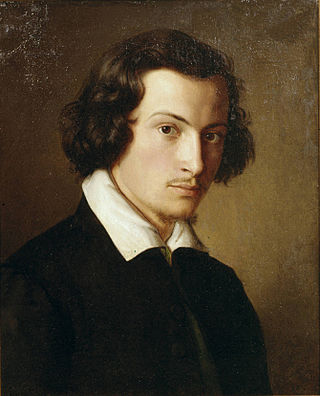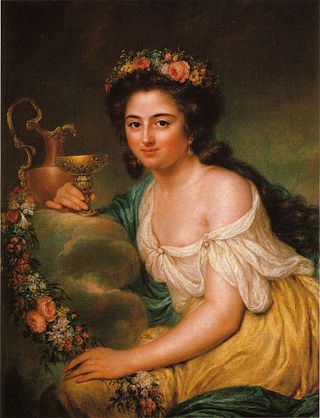Life and work
His father, Juda Veit (1716-1786), was a wool merchant and founder of a bank. He was descended from one of the fifty Jewish families that had been expelled from Vienna and settled in Brandenburg, at the invitation of Elector Friedrich Wilhelm. They were from the upper classes and possessed a "letter of protection" (Revidiertes General-Privileg [ de ]), allowing them and their descendants the right of residence.
He is best known as the first husband of Brendel Mendelssohn, who is better known as Dorothea von Schlegel, and as father of the artists, Jonas and Philipp Veit. Moses Mendelssohn had chosen Veit from among his acquaintances to be his daughter's husband, because Veit's letter of protection offered her a degree of security that could not otherwise be obtained.
They were betrothed in 1778, married in 1783, and had four children, but only Jonas and Philipp survived infancy. Both converted to Catholicism, as did their mother, and later became members of the art movement known as the Nazarenes. After sixteen unhappy years, they were divorced, in 1799. Jonas remained at home, while Philipp left with his mother. She later married the philosopher, Friedrich Schlegel.
He never converted; providing financial support for his ex-wife and sons for as long as it was needed. He was a member of the Stock Exchange Corporation, favored the reorganization of Jewish worship, according to plans proposed by David Friedländer, and contributed to charitable societies for both the Jewish and gentile poor. After Moses Mendelssohn's death, he served as an advisor to his widow, Fromet.

Moses Mendelssohn was a German-Jewish philosopher and theologian. His writings and ideas on Jews and the Jewish religion and identity were a central element in the development of the Haskalah, or 'Jewish Enlightenment' of the eighteenth and nineteenth centuries. Born to a poor Jewish family in Dessau, Principality of Anhalt, and originally destined for a rabbinical career, Mendelssohn educated himself in German thought and literature. Through his writings on philosophy and religion he came to be regarded as a leading cultural figure of his time by both Christian and Jewish inhabitants of German-speaking Europe and beyond. His involvement in the Berlin textile industry formed the foundation of his family's wealth.
The surname מענדעלסאן is transliterated to English as Mendelssohn, Mendelsson, or Mendelson. It is a common Polish/German Jewish surname. The variant spellings are used interchangeably, often even within a single family.

Philipp Veit was a German Romantic painter and one of the main exponents of the Nazarene movement. It is to Veit that the credit of having been the first to revive the nearly forgotten technique of fresco painting is due.

Karl Wilhelm FriedrichSchlegel was a German poet, literary critic, philosopher, philologist, and Indologist. With his older brother, August Wilhelm Schlegel, he was one of the main figures of Jena Romanticism.

The Bach family refers to several notable composers of the baroque and classical periods of music, the best-known of whom was Johann Sebastian Bach (1685–1750). A family genealogy was drawn up by Johann Sebastian Bach himself in 1735 when he was 50 and was completed by his son Carl Philipp Emanuel.

Abraham Abramson was a Prussian coiner and medallist. Born into a Jewish family, he later converted to Protestantism.

Rahel Antonie Friederike Varnhagen was a German writer who hosted one of the most prominent salons in Europe during the late 18th and early 19th centuries. She is the subject of a celebrated biography, Rahel Varnhagen: The Life of a Jewess (1957), written by Hannah Arendt. Arendt cherished Varnhagen as her "closest friend, though she ha[d] been dead for some hundred years". The asteroid 100029 Varnhagen is named in her honour.

Kurt Wilhelm Sebastian Hensel was a German mathematician born in Königsberg.

Henriette Julie Herz is best known for the "salonnieres" or literary salons that she started with a group of emancipated Jews in Prussia.

Jerusalem, or on Religious Power and Judaism is a book written by Moses Mendelssohn, which was first published in 1783 – the same year when the Prussian officer Christian Wilhelm von Dohm published the second part of his Mémoire Concerning the amelioration of the civil status of the Jews. Moses Mendelssohn was one of the key figures of Jewish Enlightenment (Haskalah) and his philosophical treatise, dealing with social contract and political theory, can be regarded as his most important contribution to Haskalah. The book which was written in Prussia on the eve of the French Revolution, consisted of two parts and each one was paginated separately. The first part discusses "religious power" and the freedom of conscience in the context of the political theory, and the second part discusses Mendelssohn's personal conception of Judaism concerning the new secular role of any religion within an enlightened state. In his publication Moses Mendelssohn combined a defense of the Jewish population against public accusations with contemporary criticism of the present conditions of the Prussian Monarchy.

Elisabeth Ludovika of Bavaria was Queen of Prussia as the wife of King Frederick William IV.

Dorothea Friederike von Schlegel was a German novelist and translator.

Meyer Kayserling was a German rabbi and historian.
Maskil Moses Hirschel was a German writer, polemicist and chess author.

The Mendelssohn family are the descendants of Mendel of Dessau. The German Jewish philosopher Moses Mendelssohn and his brother Saul were the first to adopt the surname Mendelssohn. The family includes his grandson, the composer Felix Mendelssohn and his granddaughter, the composer Fanny Mendelssohn.
Veit is a personal name. Notable people with the name include:
David Veit was a German doctor and writer.

Johannes Veit, originally Jonas Veit was a German history painter. After 1811, he lived and worked in Rome, where he was a member of the Nazarene movement.
Sara Grotthuis, born Sara Meyer, also known as Sophie Leopoldine Wilhelmine Baroness von Grotthuis and as Sara Wulff by her first marriage, was one of the most well-known "salonnières" of the late 18th and early 19th centuries in Berlin.
Events from the year 1839 in Germany
This page is based on this
Wikipedia article Text is available under the
CC BY-SA 4.0 license; additional terms may apply.
Images, videos and audio are available under their respective licenses.













